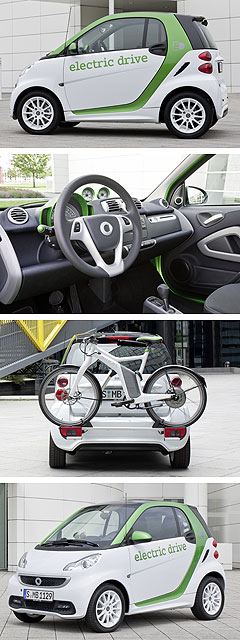Future models - Smart - ForTwo - EDAussie hopes high for all-new Smart EVA little greenie: Smart's third-generation ForTwo Electric Drive gains more power and a longer driving range on top of an expanded production run that could see it come to Australia. Production boost for 2012 third-gen Smart ForTwo ED ups chances for local release18 Aug 2011 THE all-electric version of the Smart ForTwo micro-car is closer than ever to reaching Australia after the company this week announced a significant boost in production volume for the forthcoming third-generation version. The Mercedes-Benz-owned micro-car brand is planning a “five-figure” production run at its plant in Hambach, France, where the Mk3 ForTwo Electric Drive (ED) will be built from the first half of next year. In comparison, fewer than 2000 second-generation ForTwo EDs have been built at the plant since production started in 2009. The increased volume will allow the latest iteration of the diminutive EV to be sold in more than 30 markets worldwide, including right-hand-drive countries, opening the door for a local release. But Smart’s senior manager of corporate communications in Australia, David McCarthy, told GoAuto there were still hurdles to overcome before it could import the updated model, which features big improvements to driving range and peak power output. “The biggest stumbling block is price,” he said. “For us, making a business case for it is not easy. There are a lot of people that will say they want an electric car, but when it comes to handing over their money, I think there’s a bit of a gap.  “You’re talking pretty small numbers. So are we interested? Absolutely. We’re doing the business case, but it is a challenge.” Mr McCarthy also identified the lack of charging infrastructure for electric vehicles in Australia as a stumbling block, although he recognised that the situation was improving with organisations such as Better Place becoming more established. Although Daimler chairman Dieter Zetsche said in 2008 that the plug-in ForTwo would be made available to Australians, the lack of RHD availability, limited production and priority for lease customers in progressive European cities such as Berlin has thwarted the Australian business case. Mr McCarthy said this week he would “love” to get a handful of trial cars to help make a local assessment with the new-generation model. The latest Smart ForTwo ED’s magneto-electric motor – produced as part of parent Daimler’s EM-motive joint venture with Bosch – produces peak power of 55kW and provides a claimed 130Nm of instantaneous torque. This is up on the previous model’s peak output of 30kW and 120Nm, allowing for a new top speed of 120km/h (up from 100km/h) which puts it on par with the combustion-engined Smart ForTwo on which it is based. The electric mini has a claimed 0-60km/h acceleration time of 5.0 seconds (down from 6.5 seconds) and can zip from 0-100km/h in a more respectable 13.0 seconds – quicker than the base petrol-powered ForTwo, which uses a 52kW/92Nm 1.0-litre three-cylinder engine and reaches the mark in 13.3 seconds. Smart says that the EV’s boost in power comes largely due to customer feedback on the second-generation model, with a higher top speed and better acceleration from above 60km/h listed as the main priorities. Contrary to common perceptions, the company claims the driving range was not the crucial point from the perspective of the test customers. The vast majority of users confirmed the results of surveys which say that people drive approximately 30 to 40 kilometres per day on average in urban areas. Nevertheless, Daimler engineers have replaced the Tesla Motors-supplied 14kWh lithium-ion battery from the previous model in favour of a Deutsche ACCUmotive unit with a 17.6kWh capacity. As a result, the driving range has been boosted from around 115km to a claimed 140km, while the battery can be fully charged from a household power outlet in eight hours. An optional 22kW onboard charger allows the battery pack to be completely charged in less than one hour from a quick-charging station. The latest ForTwo ED also gets a round of cosmetic upgrades including a larger grille featuring the electric drive logo, slick LED daytime driving lights below the headlamps and wider door sills. The ever-distinctive bodyshell can be had in the same wide range of colour combinations as the diesel and petrol variants and is also available as a cabrio or with a glass roof. Those who prefer to advertise their environmental credentials can also choose the electric drive design package which gives the car ‘fresh’ green highlights in addition to ‘crystal’ white panels, white alloy wheels, a green ‘tridion’ cell, green mirror caps and green interior accents. Unique features include an air-conditioning system that can be pre-cooled or pre-heated for a programmed departure time via either the power network or a new smartphone app. The company’s new iPhone application integrates trip computer information, a hands-free phone system, navigation, internet radio and the driver’s music library, while its optional Car Finder program can remedy shopping centre blues by guiding you back to wherever your car is parked. Smart says its drive app is a world-first for a car-maker, although brands like Volvo, Ford and General Motors might disagree with this claim. Standard equipment includes electric windows/mirrors, leather-clad steering wheel/gearknob, entry line radio, power steering, alloy wheels and a luggage compartment cover. The standard trip computer is programmed to give journey information including the remaining range. As with the previous model, two round instruments show the charge status of the battery and the energy used and recuperated.  Read more |
Click to shareSmart modelsResearch Smart Motor industry news |
















Facebook Twitter Instagram